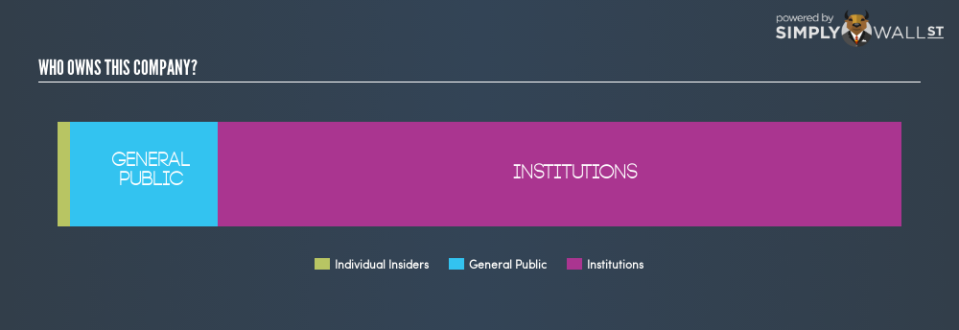Who Are The Major Shareholders Of Franco-Nevada Corporation (TSE:FNV)?

In this analysis, my focus will be on developing a perspective on Franco-Nevada Corporation’s (TSE:FNV) latest ownership structure, a less discussed, but important factor. The impact of a company’s ownership structure affects both its short- and long-term performance. Different types of investors can have varying degrees of influence on a company’s management team. For example, an active institutional investor may be more likely to hold a company accountable for certain actions whereas a passive fund will move in and out of stocks without regards to corporate governance. The implications of these institutions’ actions can either benefit or hinder individual investors, so it is important to understand the ownership composition of your stock investment. Now I will analyze FNV’s shareholder registry in more detail.
View our latest analysis for Franco-Nevada
Institutional Ownership
FNV’s 80.9% institutional ownership seems enough to cause large share price movements in the case of significant share sell-off or acquisitions by institutions, particularly when there is a low level of public shares available on the market to trade. However, as not all institutions are alike, such high volatility events, especially in the short-term, have been more frequently linked to active market participants like hedge funds. For shareholders in FNV, sharp price movements may not be a major concern as active hedge funds hold a relatively small stake in the company. Although this doesn’t necessarily lead to high short-term volatility, we should dig deeper into FNV’s ownership structure to find how the remaining owner types can affect its investment profile.
Insider Ownership
Insiders form a group of important ownership types as they manage the company’s operations and decide the best use of capital. Insider ownership has been linked to better alignment between management and shareholders. A stake of 1.6% in the large-cap FNV is relatively significant. This means there is some alignment of interest with shareholders. A higher level of insider ownership has been found to reflect the choosing of projects with higher return on investments compared to lower returning projects for the sake of expansion. I will also like to check what insiders have been doing recently with their holdings. Insider buying may be a sign of upbeat future expectations, however, selling doesn’t necessarily mean the opposite as insiders may be motivated by their personal financial needs.
General Public Ownership
A big stake of 17.5% in FNV is held by the general public. This level of ownership gives retail investors the power to sway key policy decisions such as board composition, executive compensation, and potential acquisitions. This is a positive sign for an investor who wants to be involved in key decision-making of the company.
Next Steps:
FNV’s considerably high level of institutional ownership calls for further analysis into its margin of safety. This will allow investors to reduce the impact of non-fundamental factors, such as volatile block trading impact on their portfolio value. However, ownership structure should not be the only determining factor when you’re building an investment thesis for FNV. Rather, you should be looking at fundamental drivers such as the intrinsic valuation, which is a key driver of Franco-Nevada’s share price. I highly recommend you to complete your research by taking a look at the following:
Future Outlook: What are well-informed industry analysts predicting for FNV’s future growth? Take a look at our free research report of analyst consensus for FNV’s outlook.
Past Track Record: Has FNV been consistently performing well irrespective of the ups and downs in the market? Go into more detail in the past performance analysis and take a look at the free visual representations of FNV’s historicals for more clarity.
Other High-Performing Stocks: Are there other stocks that provide better prospects with proven track records? Explore our free list of these great stocks here.
NB: Figures in this article are calculated using data from the last twelve months, which refer to the 12-month period ending on the last date of the month the financial statement is dated. This may not be consistent with full year annual report figures.
To help readers see past the short term volatility of the financial market, we aim to bring you a long-term focused research analysis purely driven by fundamental data. Note that our analysis does not factor in the latest price-sensitive company announcements.
The author is an independent contributor and at the time of publication had no position in the stocks mentioned. For errors that warrant correction please contact the editor at editorial-team@simplywallst.com.

 Yahoo Finance
Yahoo Finance 
